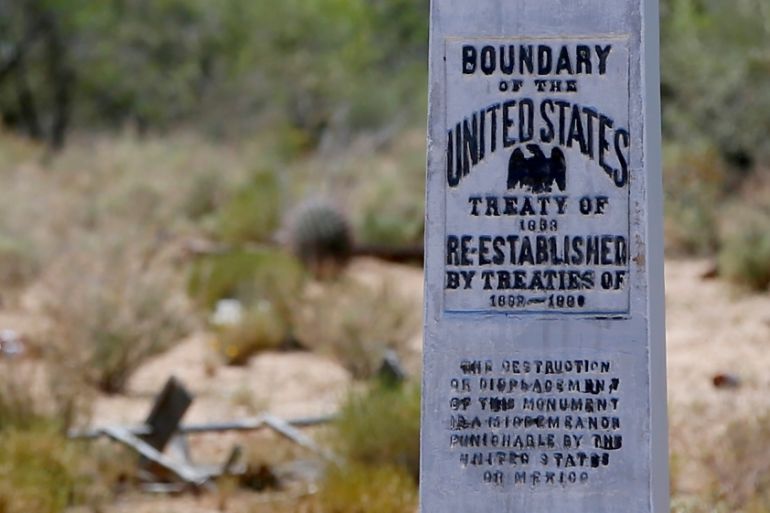We must protect sacred sites from Trump’s US-Mexico border wall
Trump is blowing up ancestral burial sites to build his wall, proving that nothing is sacred to this administration.

The chairman of the Tohono O’odham, Ned Norris, recently went to Washington, DC to provide testimony before the US Congressional House Natural Resources Committee’s Subcommittee for Indigenous Peoples on the impact that construction of Trump’s wall is having on his people. Namely, the cold, methodical, sacrilegious blasting of ancient burial sites that the Tohono O’odham hold sacred.
The tribe predates the border between the United States and Mexico, and they have members on both sides of it. He compared the dynamiting of the area, known as Monument Hill, to the wilful destruction of Arlington National Cemetery, a historical place that holds the consecrated remains of legions of American war dead and military service veterans.
Keep reading
list of 4 itemsIndigenous people in Philippines’s north ‘ready to fight’ as tensions rise
Curfew announced for under-18s in Australia’s Alice Springs after unrest
‘We exist’: A Himayalan hamlet, forgotten by Indian democracy
The chairman was emotional at times, choking back tears – and it is no wonder. That very day, mere hours earlier, the federal government had carried out its latest rounds of explosions there. The Trump administration, exhibiting the poor taste that seems to characterise it, sent out invites for the macabre event. A group of journalists watched in curiosity and horror as they witnessed the desecration of Tohono O’odham’s ancestral burial grounds.
Apache warriors, from another tribe in the region, are also interred there. The Trump administration knows that they are destroying what is essentially a cemetery. They have uncovered human bone fragments that date back thousands of years during the blasts.
In fact, the Trump administration is using federal waivers to bypass the Native American Graves Protection and Repatriation Act. Without waivers, these actions would be prohibited and illegal. The waivers originate from the Real ID Act, a post-9/11 law that grants the Department of Homeland Security sweeping and largely unchecked authority to waive other laws to construct border barriers.
Trump’s wall is also cutting through a ceremonial route that the Tohono O’odham people use for their Salt Pilgrimage, a key rite of passage for the tribe’s young men.
US Representative Deb Haaland, a member of the Laguna Pueblo tribe from New Mexico who sits on the House Natural Resources Committee, joined Norris in expressing deep concern. “When tribal leaders don’t have a seat at the table, indigenous history is lost,” she said.
Democratic Representative from Arizona Raul Grijalva, another member of the committee whose district includes the Tohono O’odham, toured Monument Hill weeks ago and was outraged by the destruction he saw taking place.
The government claims to have monitors present, but Grijalva has no faith in them, saying monitors would “do anything to avoid, mitigate, or even point out some of the sacrilegious things that are occurring and will continue to occur, given the way they’re proceeding”.
Besides obliterating the sacred sites and burial grounds of the Tohono O’odham, construction of Trump’s wall also involves draining their aquifer and bulldozing through Organ Pipe Cactus National Monument, thereby killing the plants and wildlife in the Sonoran Desert ecosystem that are critical to their tribe’s culture. Crews have uprooted and sliced through saguaro cacti, some of which are older than the border itself. A number of endangered species also call the area home, like the ocelot. The construction floodlights alone are expected to end the migration patterns of several desert animal species.
Grijalva noted that the damage being done to Tohono O’odham ancestral lands by the Trump administration is irreversible. “You’re never going to be able to put it back together,” he stated.
Organ Pipe Cactus National Monument has been designated an International Biosphere Reserve and World Heritage Site by the United Nations Educational, Scientific And Cultural Organization (UNESCO), but neither classification is impeding the Trump administration’s dogged determination to build costly, feeble, easily subverted wall – his monument to hate.
As a Dakota/Lakota woman from the Oceti Sakowin (Great Sioux Nation) who was born on the Standing Rock Indian Reservation, I have experienced the utter lack of human decency and disrespect that the Trump administration has for indigenous sacred sites. One of his first acts as president was to force the Dakota Access Pipeline through our treaty lands against our will. I cannot help but get a lump in my throat listening to the Tohono O’odham bear their souls while doing all they can to stop Trump laying waste to their graves. At Standing Rock, our eyes welled with tears and our hearts broke as we watched bulldozers crush ancestral burial sites and when we tried to protect them, as is our sacred duty, they gassed us, shot at us, and on one occasion, sicced vicious dogs on unarmed women and children. They were fully aware that they were destroying graves there too.
Even though so much of their ancestral lands have been decimated, the Tohono O’odham have requested that Customs and Border Protection create a two-mile (3.2km) buffer zone around a natural spring (Quitobaquito) and other sites in the path of the border wall that still need saving. The proposed zone would be supplemented with additional technology instead of the wall.
Nothing is sacred to this presidential administration. What is worse is there is such a lack of ethics, morality and rational thought that they refuse to acknowledge that the desecration of a cemetery, and the destruction of a unique, pristine ecosystem not found anywhere else full of animals at risk of extinction, should take precedence over an expensive nonsensical campaign promise based on racism, ignorance, and xenophobia. We cannot allow the Tohono O’odham to stand alone. Protect the sacred.
The views expressed in this article are the author’s own and do not necessarily reflect Al Jazeera’s editorial stance.
